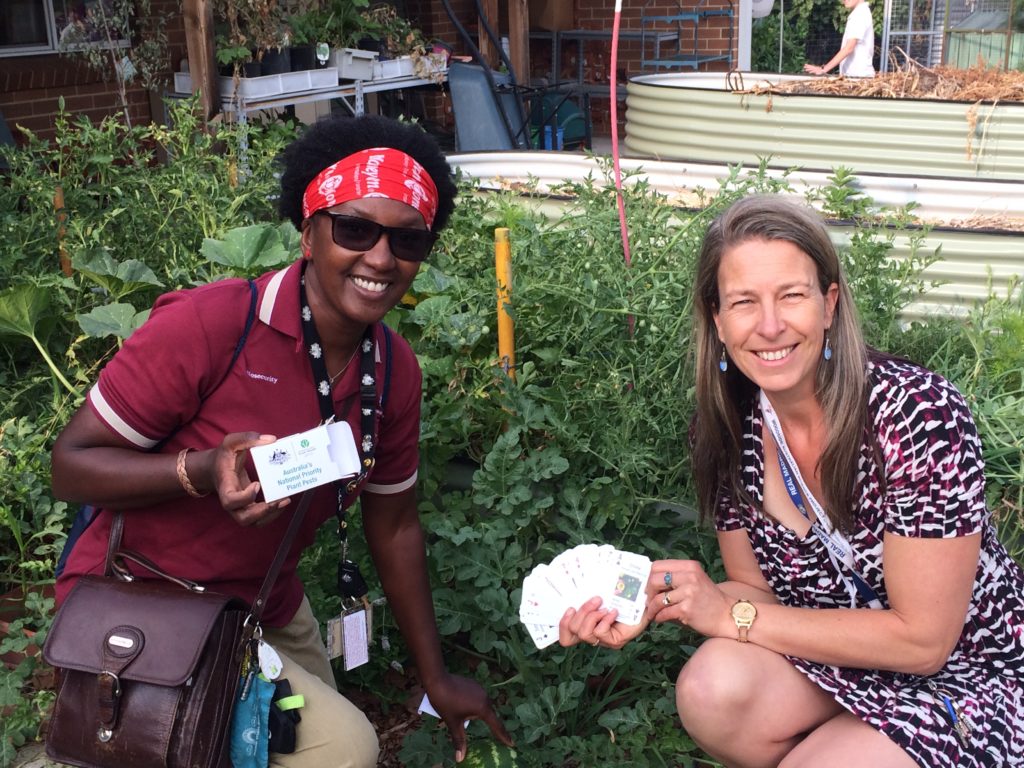How much do Australian school students know about sustainable growing practices or biosecurity? A whole bunch of stuff!
Students at Farrer Primary School could show you their abundant vegetable garden. The garden partly stocks their school canteen. It features crop rotation, chemical-free pest and disease control, and Indigenous fruit and vegetable varieties. The students have won awards at the Canberra Show for the last six years. Impressive.

Carol and Kate holding a pack of the plant pest playing cards that they designed with the students.
Award-winning environmental duo
Farrer Primary School students have benefited from a unique partnership through our STEM Professionals in Schools program. This partnership is environment teacher Kate Elliot with agricultural/environmental scientist and entomologist Carol Quashie-Williams. Carol’s expertise is linked to key components of the Australian Curriculum including biology, chemistry, earth and environmental science, and physics.
Over the seven years they have worked together, Carol and Kate have led the students in several hands-on activities. These include growing popcorn. Students observed the physical and chemical changes behind popping red, purple and yellow popcorn varieties. They have also identified fruit flies in their school garden and conducted fig propagation experiments. They have managed crop care – including a bumper crop of 51 pumpkins in one season! – and been involved in countless Science Fairs and career talks.
“Our school nominated Carol for Public Education Awards’ Volunteer of the Year in 2019, and we were unsurprised but delighted when she won,” Kate said.
“In her years volunteering, Carol has educated and inspired thousands of students. One of our past students contacted her recently to let her know that he has become an agronomist himself. He attributed it to being inspired by STEM classes with her.”
Real-world input for real-world impact
Kate said Carol is an inspiring role model – both as a scientist and as a woman from a multicultural background working in the STEM field. Her contribution enhances the experience for students, the school and its community.
“Some of our projects and experiments have led Carol to share the students’ results with the wider scientific community,” Kate said.
“She then reports back the impact of their research on policy creation and change. It’s a remarkable achievement for our students and makes science real and important to them.”
For the International Year of Plant Health during 2020, Carol and Kate and the students embarked on a shared project. They created and distributed playing cards to be used as a public education tool. The cards feature some of Australia’s national priority plant pests. Kate’s dedication to teaching the importance of biosecurity to students has been rewarded. Kate received a Biosecurity Commendation Certificate (BCC) at the Australian Biosecurity Awards 2020.
Carol describe volunteering as being just as beneficial for her as for the school. Volunteering has vastly improved her communication skills and keeps her field entomology and sustainable agricultural science skills up-to-date. It also contributes to her training and stakeholder engagement responsibilities in her work. Carol is Assistant Director for the Department of Agriculture, Water and the Environment.

Entomologist Carol Quashie-Williams accepts her Volunteer of the Year award in 2019 for being a role model and inspiration to thousands of students in the subject of science.
Getting your hands dirty
“Getting started is easy. I like to draw out what the students already know, and I always start by asking if anyone knows what an entomologist is,” Carol said.
“I often find even teachers of very young students are impressed with how much their students know about insects (such as “honey is bee vomit!”).
“Keeping concepts simple and using plain English helps, as well as using props. I’m usually wearing a pair of insect earrings or butterfly socks when I visit as well as my Department biosecurity shirt.
“I hadn’t realised that the insect life cycle was part of the biological science curriculum, and with a growing interest in sustainability and the popularity of school vegetable gardens, I find it very easy to translate my STEM skills,” she said.
CSIRO’s STEM Professionals in Schools program has made Kate and Carol’s partnership possible. The program exists to create partnerships just like theirs, between STEM professionals and schools teachers all over Australia.
Carol recently spoke at a panel event for STEM Professionals in Schools. She shared more about her career and her partnership with Kate. Watch the video to find out more.

